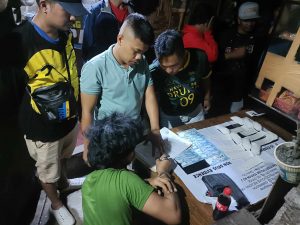As the long-gone type 2 poliovirus (PV) has been recorded anew in the Davao River and somewhere in Lanao, the health officials continue to bolster its campaign on Sabayang Patak Kontra Polio (SPKP) in Mindanao.
Due to the resurrection of the type 2 poliovirus, the DOH XI will be conducting another two rounds of bivalent Oral Polio Vaccination (bOPV) to children, 0-59 months old as “supplemental vaccination” after the 3rd round of monovalent Oral Polio Vaccination for type 2 (mOPV2).
Dr. Julinda K. Acosta, chief of the Technical Division of Davao City Health Office, said after the third round from Jan. 20 to Feb. 2, 2020, the fourth round will begin on Feb. 17 until March 1, 2020. The fifth round, meanwhile, is scheduled from March 23 to April 5, 2020.
“The additional two rounds of vaccination will be a ‘supplemental vaccination,’ which means it will provide more protection to children from the poliovirus. With our goal ‘no children left behind’ this will be a Mindanao-wide vaccination,” she said.
She revealed that type 2 PV has been already eradicated in the world in 2015 causing them to shift from tOPV (trivalent Oral Polio Vaccination) to bOPV in 2016.
“Before, we used tOPV which means vaccines for type 1, 2 and 3 are being (given via oral) intake or injected to children. However, after the eradication of the type 2 poliovirus in the world in 2015, we shifted to bOPV, which means only vaccines for type 1 and 3 are given,” she said.
She added that the World Health Organization (WHO) had predicted the return of the type 2 poliovirus. The existence of type 2 poliovirus is recorded not only in Lanao but also in the waters of the Davao River.
“The recorded type 2 PV of a certain child somewhere in Lanao is linked to the type 2 PV found in the Davao River,” she said.
After the first water sampling, the Davao River was found negative for the virus, but as another water sampling conducted, the Davao River becomes positive for type 2 PV.
“The first water sample they got was in the middle of the Davao River. It resulted in a negative result, wherein there is no direct contact with humans. However, the water sample in the next test used the water near the river bank where there are residing residences,” she said.
The existence of the virus in the Davao River has caused panic to the residents.
“People are now afraid to eat produce from waters like fishes because they think that it might be a carrier of PV,” she said.
However, she clarified that the virus can only be transmitted from animals to humans, but rather from human-to-human contact.
Supplemental vaccination
The DOH XI will intensify its Sabayang Patak Kontra Polio (SPKP) campaign to unshackle the children in Mindanao from the chain of poliovirus. “Even if the children have already received the vaccines, we will still give them another drop for them to be fully protected from the poliovirus,” Acosta said.
She emphasized that the additional vaccines in rounds four and five “is not an overdosage.”
“We have invited vaccinologists to inform the implementers of the vaccination-for them relay it to the parents- that the additional vaccines are safe for their child/children,” she said.
Amid the intensified campaign of DOH XI, there are still people and groups that resist to vaccinating their children. “There are still some religious groups and parents that won’t allow the health workers to vaccinate their children due to fear,” she said.
She added that most of the indigenous people in Paquibato District are very cooperative with their campaign.
Children who will receive mOPV in the third round shall be given an “indelible ink on their left pinky finger and adjoining skin.”
Meanwhile, those who will receive the fourth and fifth round shall have an “indelible ink on the left index finger.”
“Together with the Task Force checkpoints, schools, malls and hospitals, the implementation of SPKP in Mindanao becomes easy,” Acosta said.
Health officials are targeting 105% to achieve “hard immunity” from the poliovirus.




